catalytic converter BMW X5 4.4I 2000 Owners Manual
[x] Cancel search | Manufacturer: BMW, Model Year: 2000, Model line: X5 4.4I, Model: BMW X5 4.4I 2000Pages: 201, PDF Size: 1.93 MB
Page 11 of 201
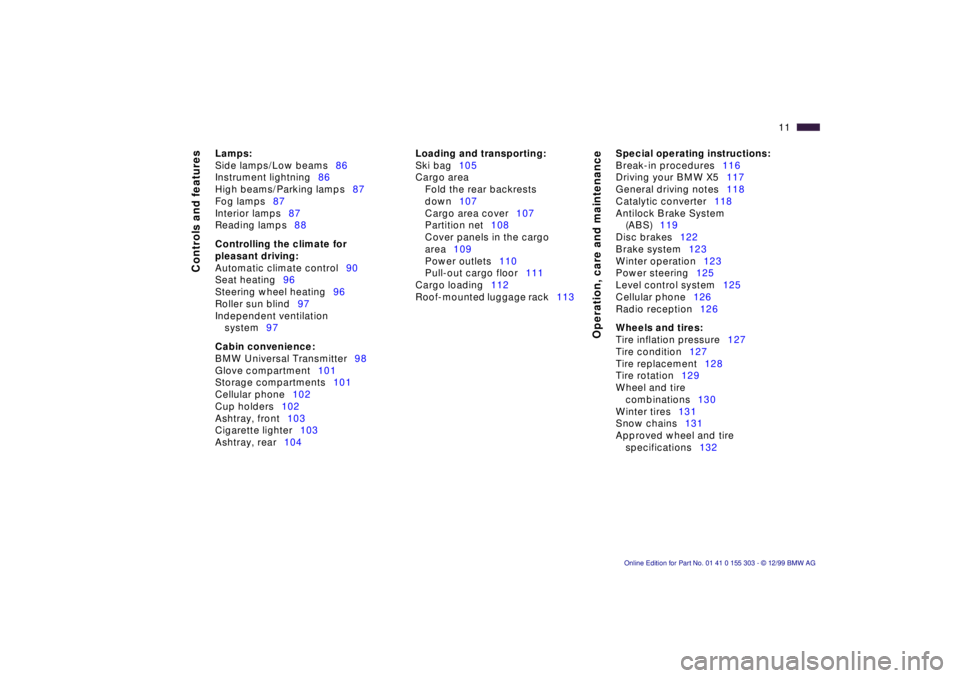
11n
Controls and features
Operation, care and maintenance
Lamps:
Side lamps/Low beams86
Instrument lightning86
High beams/Parking lamps87
Fog lamps87
Interior lamps87
Reading lamps88
Controlling the climate for
pleasant driving:
Automatic climate control90
Seat heating96
Steering wheel heating96
Roller sun blind97
Independent ventilation
system97
Cabin convenience:
BMW Universal Transmitter98
Glove compartment101
Storage compartments101
Cellular phone102
Cup holders102
Ashtray, front103
Cigarette lighter103
Ashtray, rear104
Loading and transporting:
Ski bag105
Cargo area
Fold the rear backrests
down107
Cargo area cover107
Partition net108
Cover panels in the cargo
area109
Power outlets110
Pull-out cargo floor111
Cargo loading112
Roof-mounted luggage rack113
Special operating instructions:
Break-in procedures116
Driving your BMW X5117
General driving notes118
Catalytic converter118
Antilock Brake System
(ABS)119
Disc brakes122
Brake system123
Winter operation123
Power steering125
Level control system125
Cellular phone126
Radio reception126
Wheels and tires:
Tire inflation pressure127
Tire condition127
Tire replacement128
Tire rotation129
Wheel and tire
combinations130
Winter tires131
Snow chains131
Approved wheel and tire
specifications132
Page 30 of 201
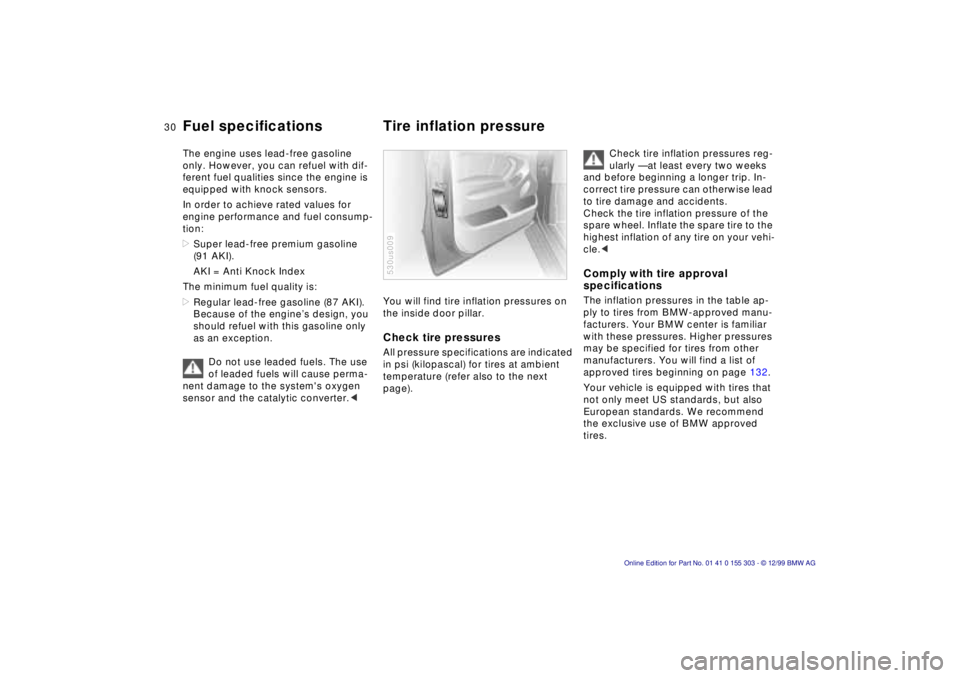
30n
Fuel specifications Tire inflation pressure The engine uses lead-free gasoline
only. However, you can refuel with dif-
ferent fuel qualities since the engine is
equipped with knock sensors.
In order to achieve rated values for
engine performance and fuel consump-
tion:
>Super lead-free premium gasoline
(91 AKI).
AKI = Anti Knock Index
The minimum fuel quality is:
>Regular lead-free gasoline (87 AKI).
Because of the engineÕs design, you
should refuel with this gasoline only
as an exception.
Do not use leaded fuels. The use
of leaded fuels will cause perma-
nent damage to the system's oxygen
sensor and the catalytic converter.<
You will find tire inflation pressures on
the inside door pillar. Check tire pressures All pressure specifications are indicated
in psi (kilopascal) for tires at ambient
temperature (refer also to the next
page). 530us009
Check tire inflation pressures reg-
ularly Ñ at least every two weeks
and before beginning a longer trip. In-
correct tire pressure can otherwise lead
to tire damage and accidents.
Check the tire inflation pressure of the
spare wheel. Inflate the spare tire to the
highest inflation of any tire on your vehi-
cle.<
Comply with tire approval
specifications The inflation pressures in the table ap-
ply to tires from BMW-approved manu-
facturers. Your BMW center is familiar
with these pressures. Higher pressures
may be specified for tires from other
manufacturers. You will find a list of
approved tires beginning on page 132.
Your vehicle is equipped with tires that
not only meet US standards, but also
European standards. We recommend
the exclusive use of BMW approved
tires.
Page 75 of 201
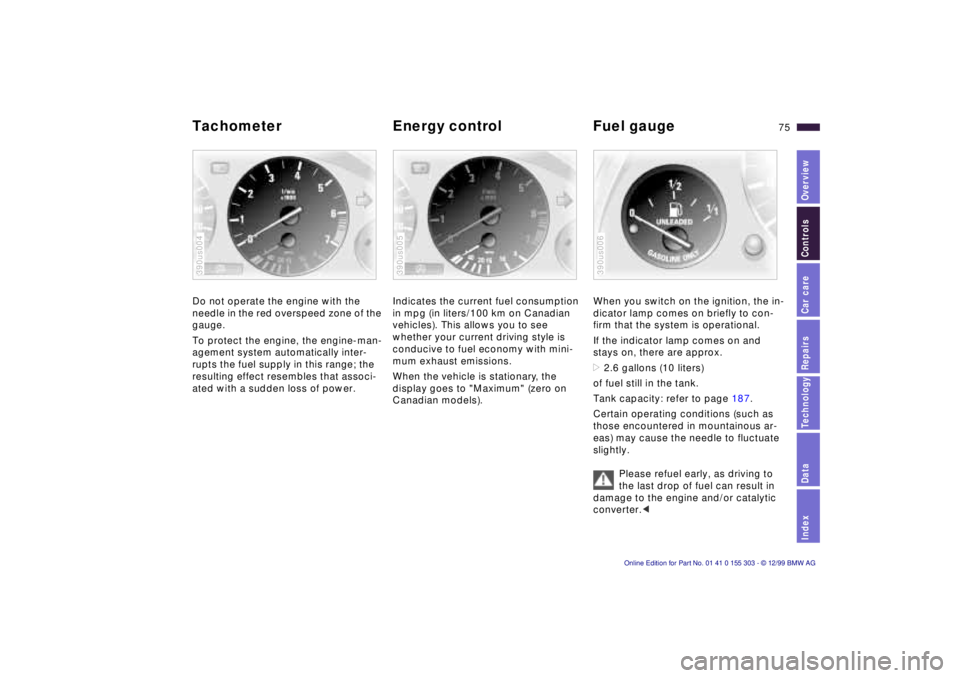
IndexDataTechnologyRepairsCar careControlsOverview
75n
Tachometer Energy control Fuel gauge Do not operate the engine with the
needle in the red overspeed zone of the
gauge.
To protect the engine, the engine-man-
agement system automatically inter-
rupts the fuel supply in this range; the
resulting effect resembles that associ-
ated with a sudden loss of power. 390us004
Indicates the current fuel consumption
in mpg (in liters/100 km on Canadian
vehicles). This allows you to see
whether your current driving style is
conducive to fuel economy with mini-
mum exhaust emissions.
When the vehicle is stationary, the
display goes to "Maximum" (zero on
Canadian models). 390us005
When you switch on the ignition, the in-
dicator lamp comes on briefly to con-
firm that the system is operational.
If the indicator lamp comes on and
stays on, there are approx.
>2.6 gallons (10 liters)
of fuel still in the tank.
Tank capacity: refer to page 187.
Certain operating conditions (such as
those encountered in mountainous ar-
eas) may cause the needle to fluctuate
slightly.
Please refuel early, as driving to
the last drop of fuel can result in
damage to the engine and/or catalytic
converter.< 390us006
Page 115 of 201
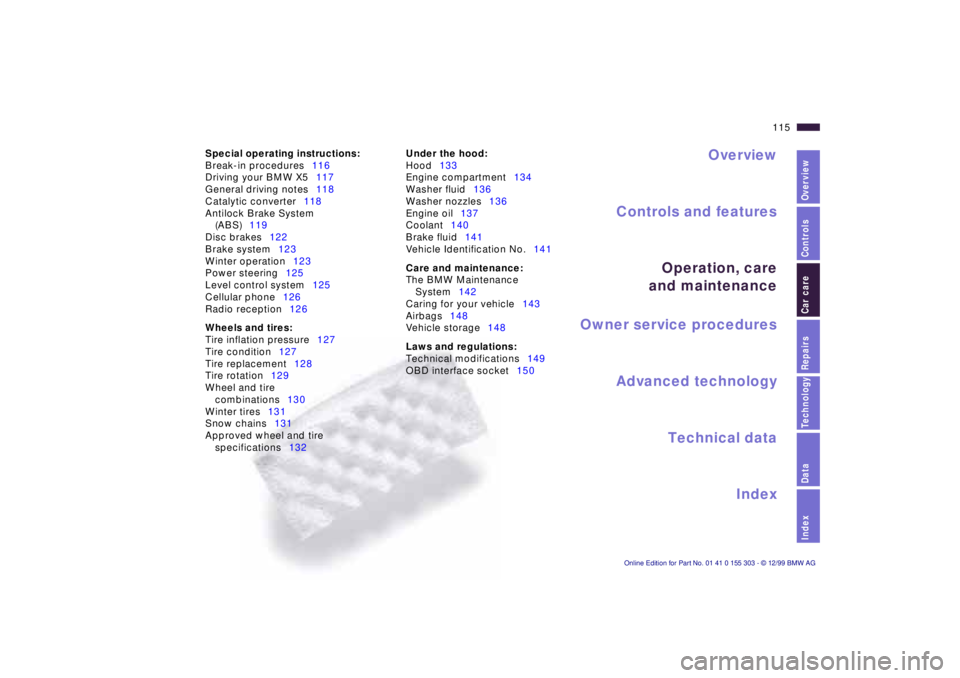
IndexDataTechnologyRepairsCar careControlsOverview
Overview
Controls and features
Operation, care
and maintenance
Owner service procedures
Technical data
Index Advanced technology
115n
Car care Special operating instructions:
Break-in procedures116
Driving your BMW X5117
General driving notes118
Catalytic converter118
Antilock Brake System
(ABS)119
Disc brakes122
Brake system123
Winter operation123
Power steering125
Level control system125
Cellular phone126
Radio reception126
Wheels and tires:
Tire inflation pressure127
Tire condition127
Tire replacement128
Tire rotation129
Wheel and tire
combinations130
Winter tires131
Snow chains131
Approved wheel and tire
specifications132Under the hood:
Hood133
Engine compartment134
Washer fluid136
Washer nozzles136
Engine oil137
Coolant140
Brake fluid141
Vehicle Identification No.141
Care and maintenance:
The BMW Maintenance
System142
Caring for your vehicle143
Airbags148
Vehicle storage148
Laws and regulations:
Technical modifications149
OBD interface socket150
Page 118 of 201

118n
General driving notes Catalytic converter
Brakes:
Do not drive with your foot resting
on the brake pedal. Even light but con-
sistent pedal pressure can lead to high
temperatures, brake wear and possibly
even brake failure.
Aquaplaning:
When driving on wet or slushy roads,
reduce vehicle speed. If you do not, a
wedge of water may form between the
tires and the road surface. This phe-
nomenon is referred to as aquaplaning
or hydroplaning. It is characterized by a
partial or complete loss of contact be-
tween the tires and the road surface.
The ultimate results are loss of steering
and braking control.
Cargo area cover:
Do not place heavy or hard objects on
the cargo area cover. These objects
could endanger vehicle occupants dur-
ing heavy brake applications or evasive
maneuvers.
Clothes hooks:
When suspending articles of clothing
from the hooks, be sure that they will
not obstruct the driver's vision. Do not
hang heavy objects on the hooks. If you
do so, they could cause personal injury
during braking or evasive maneuvers.< The catalytic converter reduces harmful
exhaust emissions.
It is designed for use with unleaded fuel
only. Even minute quantities of lead
would be enough to permanently dam-
age both the catalytic converter and the
system oxygen sensor.
To ensure efficient, trouble-free engine
operation and avoid potential damage:
>Be sure to comply with the scheduled
maintenance requirements.
>Fill the fuel tank well before it is
empty.
>When the battery is discharged, start
the engine with an outside starting
aid.
>Avoid other situations in which the
fuel is not burned, or burns incom-
pletely, such as engaging the starter
frequently or for extended periods, or
repeated start attempts in which the
engine does not start (stopping and
restarting an engine which is running
properly does not present a problem).
Never allow the engine to run with
any of the spark plug cables discon-
nected.
Page 119 of 201
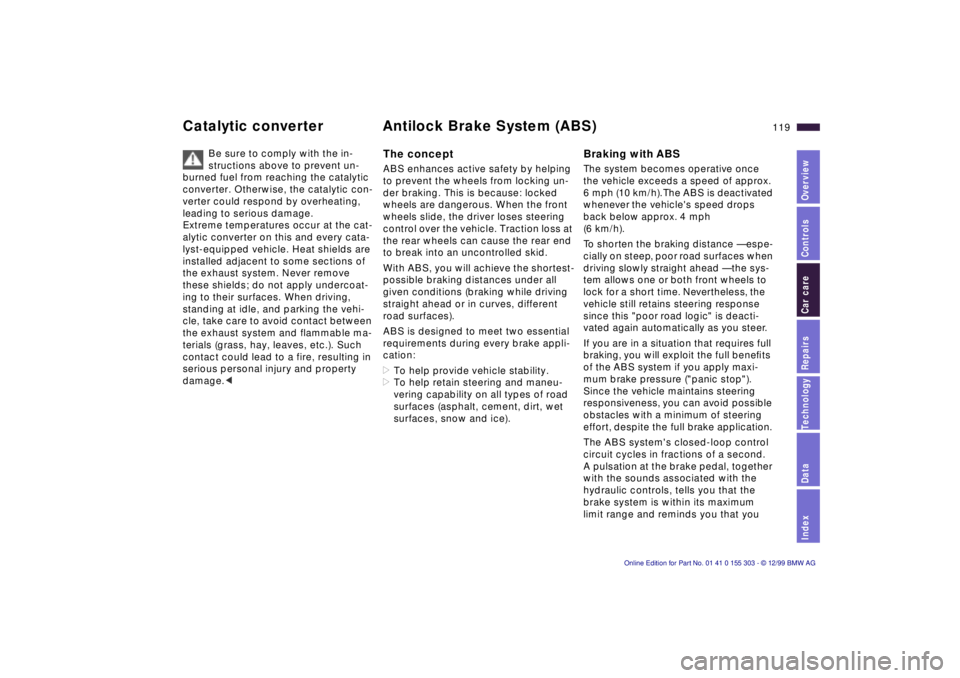
IndexDataTechnologyRepairsCar careControlsOverview
119n
Catalytic converter Antilock Brake System (ABS)
Be sure to comply with the in-
structions above to prevent un-
burned fuel from reaching the catalytic
converter. Otherwise, the catalytic con-
verter could respond by overheating,
leading to serious damage.
Extreme temperatures occur at the cat-
alytic converter on this and every cata-
lyst-equipped vehicle. Heat shields are
installed adjacent to some sections of
the exhaust system. Never remove
these shields; do not apply undercoat-
ing to their surfaces. When driving,
standing at idle, and parking the vehi-
cle, take care to avoid contact between
the exhaust system and flammable ma-
terials (grass, hay, leaves, etc.). Such
contact could lead to a fire, resulting in
serious personal injury and property
damage.<
The concept ABS enhances active safety by helping
to prevent the wheels from locking un-
der braking. This is because: locked
wheels are dangerous. When the front
wheels slide, the driver loses steering
control over the vehicle. Traction loss at
the rear wheels can cause the rear end
to break into an uncontrolled skid.
With ABS, you will achieve the shortest-
possible braking distances under all
given conditions (braking while driving
straight ahead or in curves, different
road surfaces).
ABS is designed to meet two essential
requirements during every brake appli-
cation:
>To help provide vehicle stability.
>To help retain steering and maneu-
vering capability on all types of road
surfaces (asphalt, cement, dirt, wet
surfaces, snow and ice).
Braking with ABS The system becomes operative once
the vehicle exceeds a speed of approx.
6 mph (10 km/h). The ABS is deactivated
whenever the vehicle's speed drops
back below approx. 4 mph
(6 km/h).
To shorten the braking distance Ñ espe-
cially on steep, poor road surfaces when
driving slowly straight ahead Ñ the sys-
tem allows one or both front wheels to
lock for a short time. Nevertheless, the
vehicle still retains steering response
since this "poor road logic" is deacti-
vated again automatically as you steer.
If you are in a situation that requires full
braking, you will exploit the full beneÞts
of the ABS system if you apply maxi-
mum brake pressure ("panic stop").
Since the vehicle maintains steering
responsiveness, you can avoid possible
obstacles with a minimum of steering
effort, despite the full brake application.
The ABS system's closed-loop control
circuit cycles in fractions of a second.
A pulsation at the brake pedal, together
with the sounds associated with the
hydraulic controls, tells you that the
brake system is within its maximum
limit range and reminds you that you
Page 150 of 201
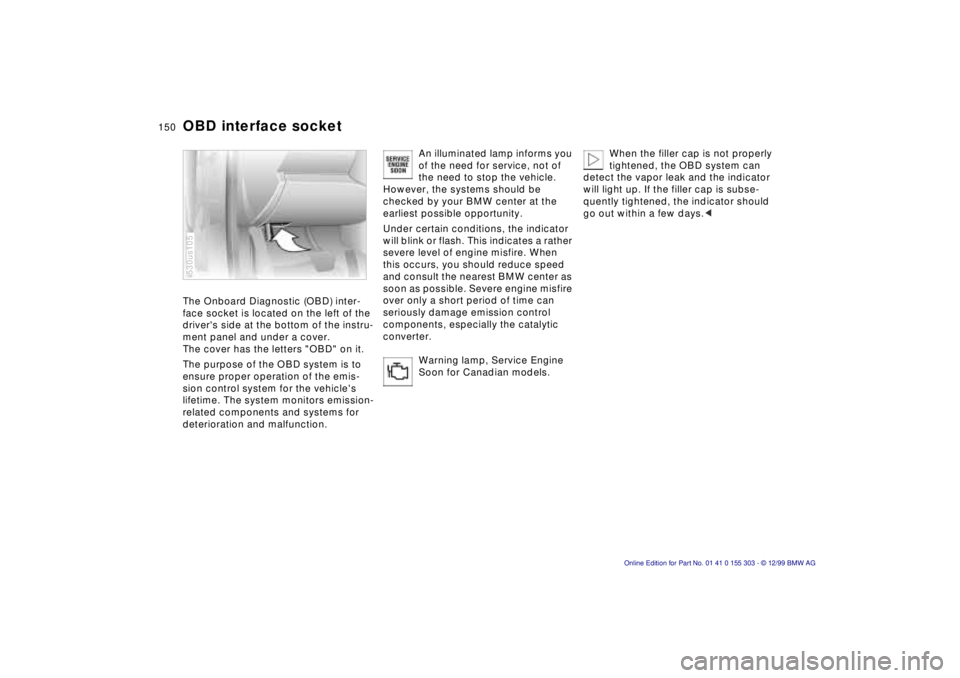
150n
OBD interface socket The Onboard Diagnostic (OBD) inter-
face socket is located on the left of the
driver's side at the bottom of the instru-
ment panel and under a cover.
The cover has the letters "OBD" on it.
The purpose of the OBD system is to
ensure proper operation of the emis-
sion control system for the vehicle's
lifetime. The system monitors emission-
related components and systems for
deterioration and malfunction. 530us105
An illuminated lamp informs you
of the need for service, not of
the need to stop the vehicle.
However, the systems should be
checked by your BMW center at the
earliest possible opportunity.
Under certain conditions, the indicator
will blink or flash. This indicates a rather
severe level of engine misfire. When
this occurs, you should reduce speed
and consult the nearest BMW center as
soon as possible. Severe engine misfire
over only a short period of time can
seriously damage emission control
components, especially the catalytic
converter.
Warning lamp, Service Engine
Soon for Canadian models.
When the filler cap is not properly
tightened, the OBD system can
detect the vapor leak and the indicator
will light up. If the filler cap is subse-
quently tightened, the indicator should
go out within a few days.<
Page 192 of 201
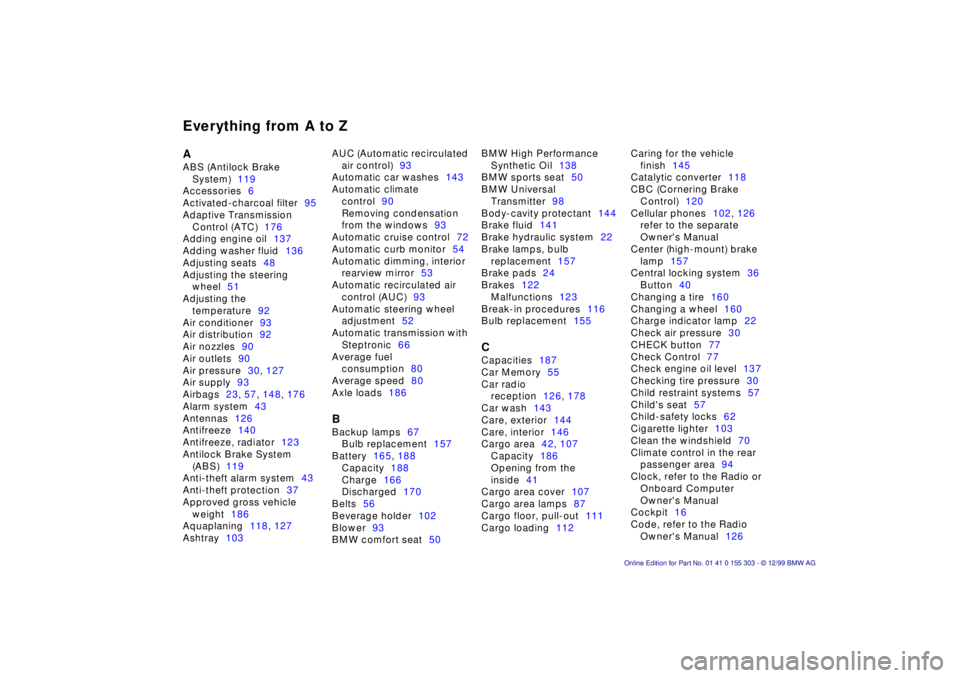
Everything from A to ZAABS (Antilock Brake
System)119
Accessories6
Activated-charcoal filter95
Adaptive Transmission
Control (ATC)176
Adding engine oil137
Adding washer fluid136
Adjusting seats48
Adjusting the steering
wheel51
Adjusting the
temperature92
Air conditioner93
Air distribution92
Air nozzles90
Air outlets90
Air pressure30, 127
Air supply93
Airbags23, 57, 148, 176
Alarm system43
Antennas126
Antifreeze140
Antifreeze, radiator123
Antilock Brake System
(ABS)119
Anti-theft alarm system43
Anti-theft protection37
Approved gross vehicle
weight186
Aquaplaning118, 127
Ashtray103AUC (Automatic recirculated
air control)93
Automatic car washes143
Automatic climate
control90
Removing condensation
from the windows93
Automatic cruise control72
Automatic curb monitor54
Automatic dimming, interior
rearview mirror53
Automatic recirculated air
control (AUC)93
Automatic steering wheel
adjustment52
Automatic transmission with
Steptronic66
Average fuel
consumption80
Average speed80
Axle loads186
BBackup lamps67
Bulb replacement157
Battery165, 188
Capacity188
Charge166
Discharged170
Belts56
Beverage holder102
Blower93
BMW comfort seat50BMW High Performance
Synthetic Oil138
BMW sports seat50
BMW Universal
Transmitter98
Body-cavity protectant144
Brake fluid141
Brake hydraulic system22
Brake lamps, bulb
replacement157
Brake pads24
Brakes122
Malfunctions123
Break-in procedures116
Bulb replacement155
CCapacities187
Car Memory55
Car radio
reception126, 178
Car wash143
Care, exterior144
Care, interior146
Cargo area42, 107
Capacity186
Opening from the
inside41
Cargo area cover107
Cargo area lamps87
Cargo floor, pull-out111
Cargo loading112Caring for the vehicle
finish145
Catalytic converter118
CBC (Cornering Brake
Control)120
Cellular phones102, 126
refer to the separate
Owner's Manual
Center (high-mount) brake
lamp157
Central locking system36
Button40
Changing a tire160
Changing a wheel160
Charge indicator lamp22
Check air pressure30
CHECK button77
Check Control77
Check engine oil level137
Checking tire pressure30
Child restraint systems57
Child's seat57
Child-safety locks62
Cigarette lighter103
Clean the windshield70
Climate control in the rear
passenger area94
Clock, refer to the Radio or
Onboard Computer
Owner's Manual
Cockpit16
Code, refer to the Radio
Owner's Manual126